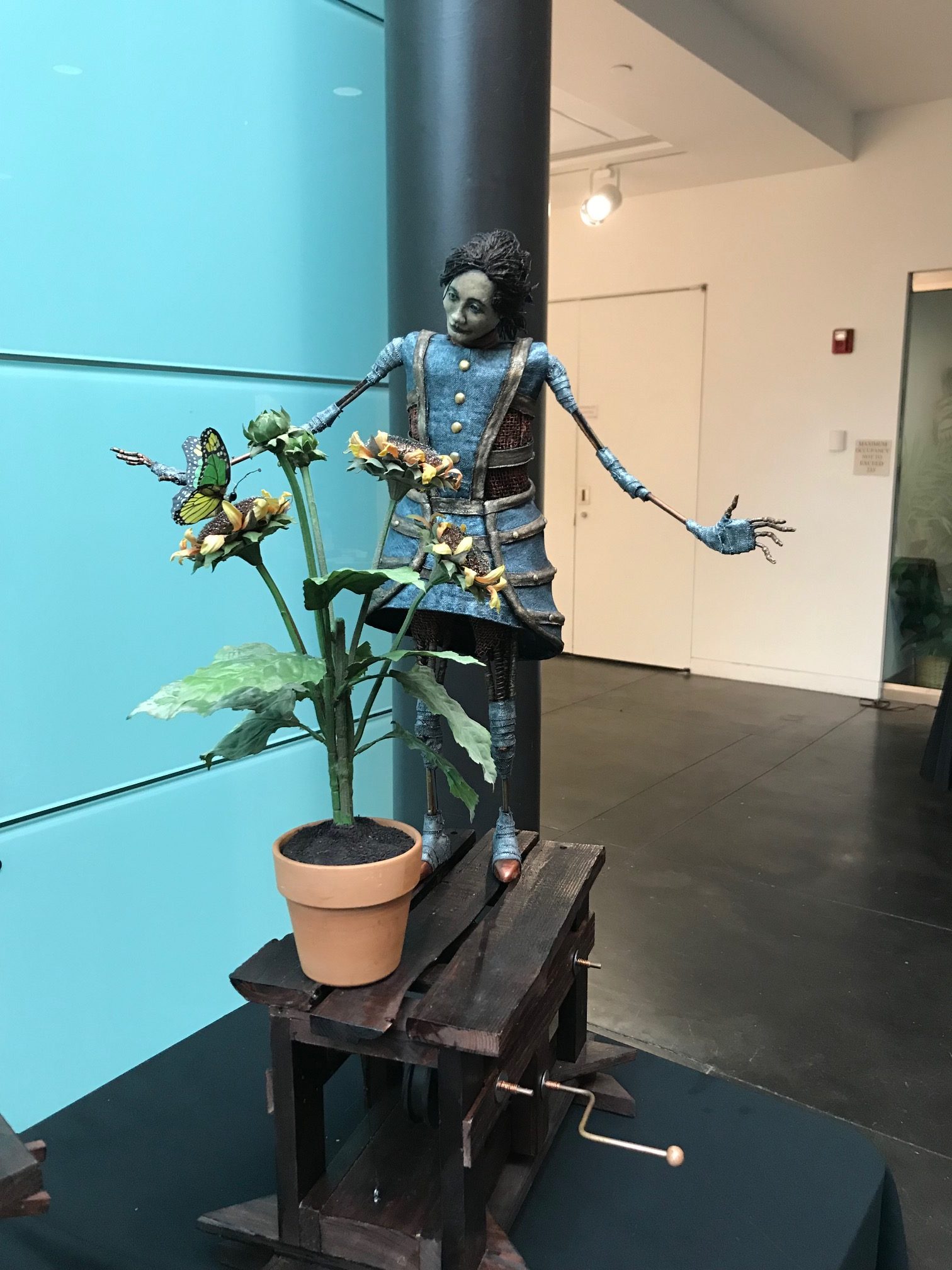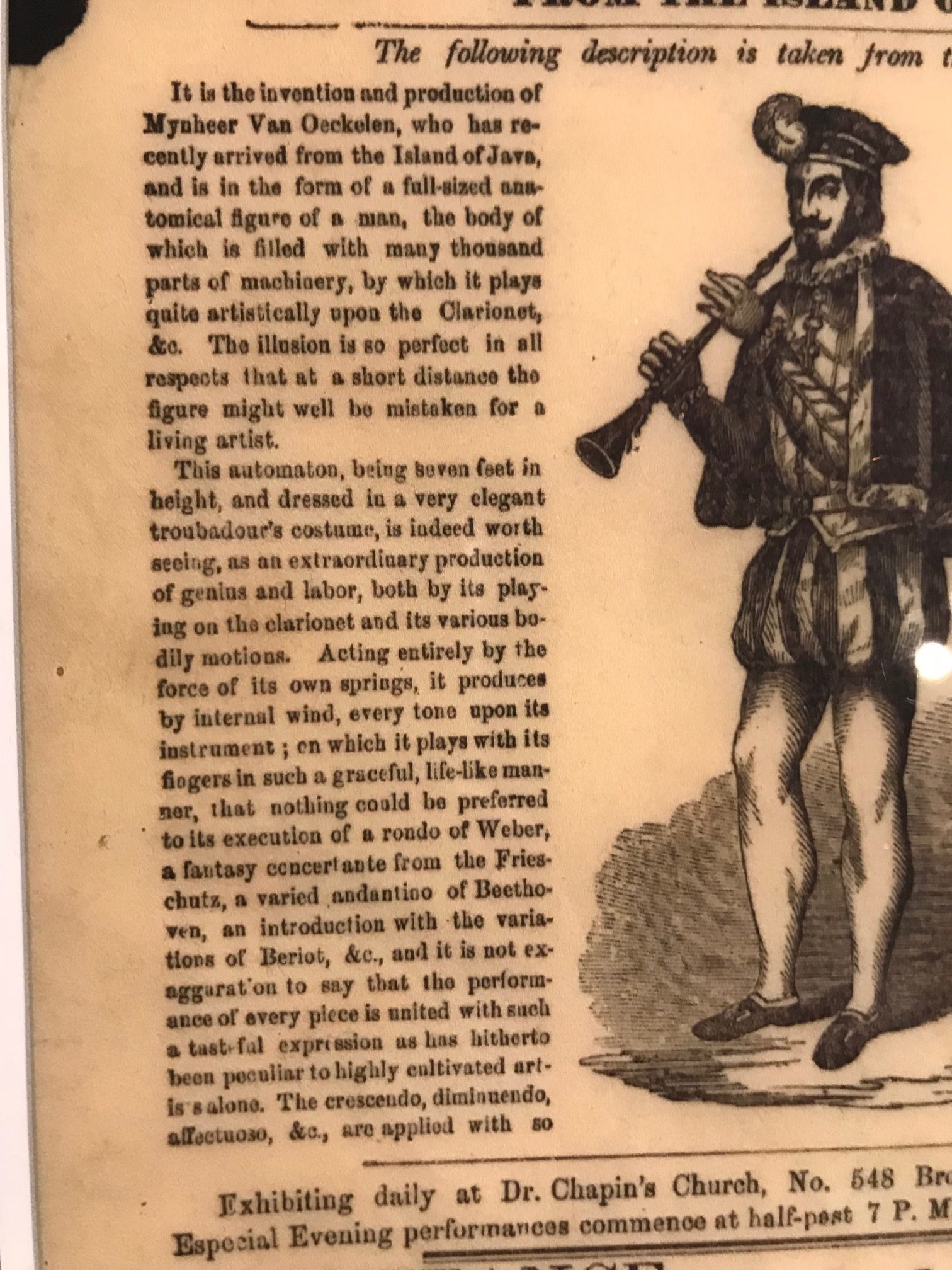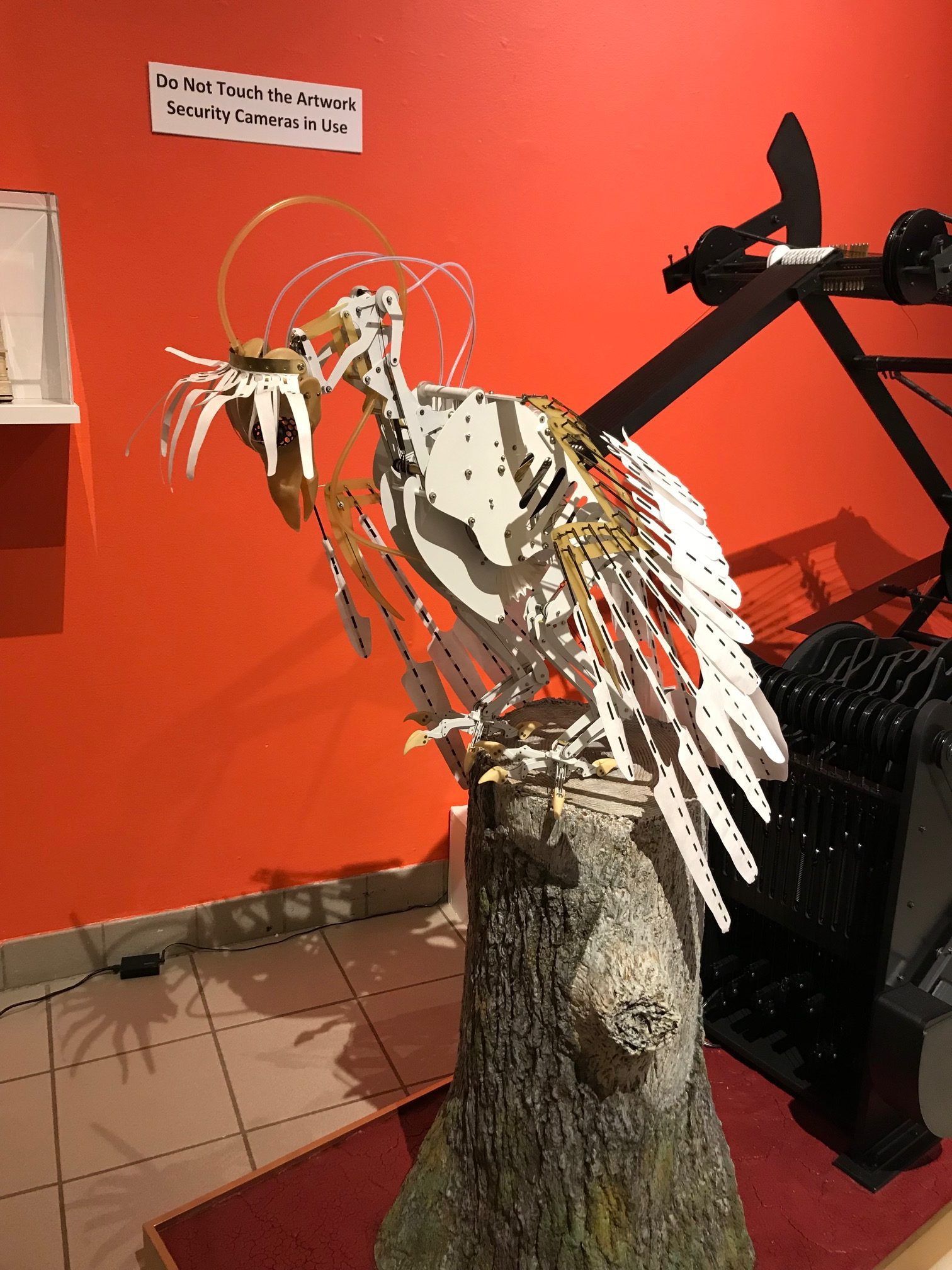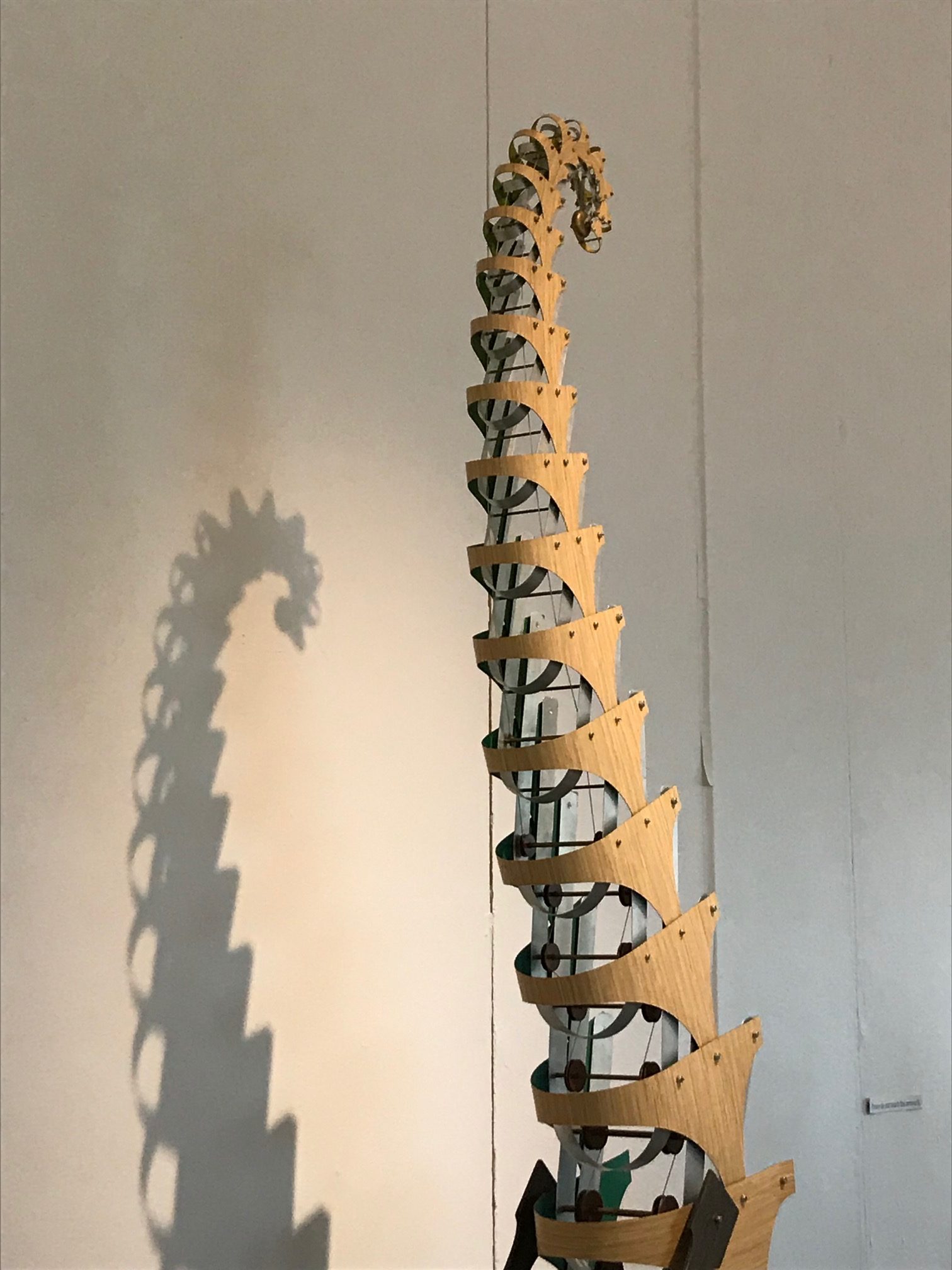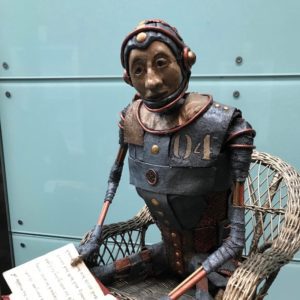
I pause at Ave Rose’s table at the third annual AutomataCon in Morristown, New Jersey when I overhear her saying that she once sold a glass cabinet of mechanized butterflies to a collector for ten thousand dollars. She turns her eyes, artificially blue with colored contacts, towards me as I take in her current installation: a small cauldron of tiny skeletons and metal bits bobbing up and down with the crank’s turn. Rose gestures to the largest creature in this moving tableau. “The demon is made out of a preserved goat’s tongue.” Sure enough, the shape is peachy beneath its pearlescent glaze and lumpy in exactly the way a shriveled, vertically propped tongue would be.
“My one criticism is, raise your prices!” This is Dug North, Rose’s neighboring exhibitor whose attention is momentarily divided between myself, Rose, and a child squeezing the handle attached to his automaton Inhabited Hat. A wooden gremlin—a softie compared to Rose’s goat tongue—pops out of the piece’s titular headwear.
My immediate sense is that North’s cursory devotion is calculated, that he believes every exchange could lead to a business transaction, and thus he doles out compliments like a used car salesman. Or, am I projecting smarm onto his black satin vest and “raise your prices” effusion? North would do well put into a nineteenth-century carnival booth after being plucked out of the Morris Museum, our venue for the rainy May convention weekend.
Automata seems to be a field dominated by white men, middle aged and older. None wear steam-punk-inspired goggles and top hats, but all seem ready to launch into an in-depth discussion of gear mechanics and carving techniques at the slightest provocation. Ave Rose is a notable exception—her diatribes detail carcass sourcing—as is Lindsey Pei, one of the few other women crafters. Although Pei’s wares are delicate where Rose’s are demonic, the two women share common inspiration. Pei writes on her website, Ornament Incarnate (tagline “Ornamental Automata & Mechanical Jewels”): “It was a fascination for animal skeletons that indirectly led me to the arcane field of mechanical watchmaking.” From there, she shifted to intricate, nature-inspired automata. Pei displays an impeccably crafted metal chameleon, complete with a roving gemstone eye and curling jointed tail; a cloud pendant with droplets of crystal rain falling from its inner cogs; and two katydids holding an emerald stone between their corundum bearings.
In the modestly sized exhibitors’ hall, a break in one of the table rows frames the doorway to the Morris Museum’s permanent Murtogh D. Guinness Collection of automata and mechanical instruments from centuries past. Since their heyday at eighteenth- and nineteenth-century carnivals and World Fairs, automata have become a little more homogenized. The automatons that fascinated Western Europeans were often crafted in the likeness of exotic peoples—heightening their spectacle. The most well-known example of this was the chess-playing Turk. According to master illusionist John Gaughan, whose historical lecture about the Turk drew the largest crowd (forty to fifty people) at AutomataCon, the chess player was invented for court entertainment. Maria Theresa of Austria—”like any empress”—loved to be impressed. To that end, inventor Wolfgang von Kempelen presented her with the chess player in 1769. The Turk could beat practiced opponents, out-strategize the court’s most confident players, and shame proven masters. Seated at a hefty table, head wrap brushing the tops of dark brows, left hand grasping a long smoking pipe, this chess playing machine soon embarked on a world tour, enthralling the public and stumping scholars of its time (including Edgar Allen Poe). As to its true secret, Gaughan mentions a panograph, but won’t explicitly say that the Turk was operated by a human concealed by trap doors within the large table.
The Turk perished in a fire in 1854, but it lives on in film and literature. (For sale at AutomataCon, Jane Irwin’s graphic novel Clockwork Game: The Illustrious Career of a Chess-Playing Automaton recounts a version of the Turk’s origins similar to Gaughan’s telling.) Aside from those in the Guinness collection, there are three historical dolls on display in the exhibitor’s hall: a rosy-cheeked man with pin-stripe pants and a pig on his lap; a Japanese doll holding a small saucer; and a cross-legged, seated hookah smoker draped in velvet and satin. The latter is attributed to Léopold Lambert, who created his Turk Fumeur models with “numerous shades of painted complexion,” according to the accompanying fact sheet. Elsewhere in the hall, the crafted figures mimic the homogeneity of their makers in shades of peach plastic and blond wood.
Unlike their predecessors, AutomataCon artists don’t seem overly concerned with hyperrealistic figuration—which they could veritably achieve with polymer printing and skilled painting. Instead, the artists tend towards the nostalgic and the simple. Georgia-based artist Tom Haney creates Edward Gorey-esque storybook stages. A hapless puppet dances, limbs pulled unremittingly by automated strings. On the adjacent stage, a man wrangles a kite in vain, line tangled in front of a painted aqua sky. These hints of melancholy elevate their automaton charm.
Jim Casey, another Southern artist, displays humanoids in Tin Man dress. When I activate the pulleys beneath a little reading man, he pauses mid-page flip to look up at me expectantly. The hand crank on Casey’s ponytailed female figurine causes her to bend over and stick her nose in a metal sunflower. Nearby, a set of anthropomorphized jewelry boxes animated by Barney Stone bicker, one ranting while the other emits sullen one-syllable responses. John Morgan’s largest display is a wooden boy crammed into a gallon-sized jar. He raps forlornly against his glass cage when his button is pushed.
Apart from the concerted effort by these crafters to appeal to our sympathy, the whirring, bobbing collection calls to mind Disneyland’s animatronic It’s a Small World ride, where cuckoo bird clock rhythms mechanize a smiling, tilting sun dial, and golden weathervanes spin on the castle as singing dolls pop out of white doors below. As a child, I remember being utterly entranced by this tableau. Kids in attendance at AutomataCon are appropriately enticed by the calls to action in the form of buttons, handles, and cranks that set miniature people and animals into motion.
Yet, it’s clear that the gears aren’t meant for ruthless five-year-old hands. The pulleys catch; the cogs stick. The inventors have achieved an impressive array of mechanized functions, but automata’s whimsy can mislead you into assuming them playthings.
Ornamental yet functional, mobile yet fragile—do these aesthetic humanoids belong more to the realm of novelty or art? Surely, every exhibitor would vote the latter, as would the speakers who traveled from near and far for the two-day event. Marian van Dijk, director of the Museum Speelklok in Utrecht, Netherlands, touts music from mechanical instruments. Michael and Maria Start of Scotland discuss their work with automata for film. Associate Executive Director of the Pen + Brush gallery in Manhattan Dawn Delikat presents a series of slides positing that although automata artists haven’t seen the mainstream fame of their visual arts contemporaries, they were actually historically ahead of painters and sculptors. Her slides juxtapose Rodin sketching Cambodian dancers with a Cambodian dancer automaton. The crux of her presentation, a figurine with surrealist question marks and symbols painted on its clownish visage, predates the Dada and Dali heyday.
However, the weekend’s organizers aren’t helping to legitimize their medium as an art form by calling its headline event “AutomataCon.” My traipse through the exhibitor’s hall—which clocked forty-two minutes at a leisurely pace, including my conversations with Rose, North, Pei, Casey, Haney, and Stone—didn’t do much to dislodge my sense that Casey switched from artist to hobbyist when he made his move from painting to automata-making. Although, perhaps an artist convention by any other name is an art fair—maybe all they have to do is replace “Con” with “Basel” and “Makers Mashup” with “Art Talk” and the collectors would flock.
Attempting to keep an open mind, I peruse the Guinness collection while waiting for van Dijk’s talk, “Dancing with the Droids (Music/Tech).” While I take in the mechanical instruments on display, a member of the museum staff offers to start the violin. He opens the case to reveal a well-worn nickel waiting inside. The coin clinks through the machinery with a Pavlovian fair-scene sounds. After a four-second delay, the instrument launches into an early twentieth century blues song. I’m as impressed by the mechanics—an army of little metal arms depressing keys that strum the strings—as I am disappointed by the effect. Apparatuses clack alongside the acoustic notes, and the melodies are clear but loud and artless. “Amazing, isn’t it?” my momentary guide asks. “We think we’re so smart today; amazing what they achieved back then.”
It is amazing. But what is it? As someone who works in the arts and is probably more snobbish than warranted about such things, I do believe that the term “art” is thrown around too generously. (As in, yes, your four-year old’s finger painting looks fantastic on the fridge, but, no, it’s not comparable to a Pollock.) I wonder at mechanical instruments and their humanoid automaton cousins—are the picture they cut or the music they produce “art,” or are they merely feats of engineering? I lean towards adjectives like “quaint” and “cute” to describe automata, rather than the more highbrow “beautiful” and “artistic.” But I’m also fixated on the fact that some of the human creators are grandfathers and grandmothers in the sense that their creations create scenes or sounds. The self-playing violin, however haltingly, makes music. But, is it art?
In carefully pronounced English, van Dijk emphasizes that at the Museum Speelklok, you’ll hear live, not recorded, music. She plays a video showing the museum’s main attractions: The street organ named Arabier clamors from inside its candy-colored cabinet, decorated with palm fronds and Arab men wearing keffiyeh surrounding its three focal white dancers. Speelklok’s Violina, a single Orchestrion unit with three violins encased above a piano, manages tunes that normally require the careful articulation of two hundred and sixteen human hand bones—plus the vigorously dipping chins, furrowed brows, and general gusto we expect of an expert violinist or pianist.
Automata makers have attempted to copy the performance elements missing from a mechanically played song. The French-made “Double Tinos” from the 1920s and 30s featured an accordion playing simulacrum of Tino Rossi, alongside an—as far as I can glean from van Dijk’s talk and later, Internet research—unnamed black percussionist. Without particular regard for musical measure, the players’ heads scan back and forth as if upon onlookers, and their mouths open and close.
Regarding a 1857 promotional bill headlined “A Great, Mechanical, Anatomical and Musical Wonder: the Automaton Musician from the Island of Java,” a copywriter (who probably never saw many live music concerts) stated:
This automaton, being seven feet in height, and dressed in a very elegant troubadour’s costume, is indeed worth seeing, as an extra ordinary production of genius and labor, both by its playing on the clarionet [sic] and its various bodily motions. Acting entirely by the force of its own springs, it produces by internal wind, every tone upon its instrument; on which it plays with its fingers in such a graceful, life-like manner, that nothing could be preferred to its execution of a rondo of Weber…
Nothing, except an actual human, one would think. But the bill continues: “the most accomplished musician on the clarinet could have no more accuracy, neither better expression of feeling, nor higher energy; in a word, no more efficacious and delightful handling of an instrument.”
I’m skeptical. The mechanical violin has nothing on a human performance. The tight-lipped Double Tinos were a marvel for their time, but no replacement for a live duo. Even musicians in our likeness can’t match the warm-blooded effect of one of our own: the delicate quivering of a pinky finger eking out a tremolo, hair falling moodily and flipping mightily over depressed bass clef keys.
This is why we’re concert goers—why we still pay for tickets when we can stream soundbites for free. It’s moving to watch a live performance. In the case of those of us who break out into dance, we’re literally moved by another human. If this shared event between performer and audience member, musician and dancer, falls short of being emotionally moving, the critic’s clinchers are “soulless,” “robotic”—damning adjectives for art, but mere statements of fact with regards to automata.
Van Dijk’s hypothesis is that robots just aren’t there yet. She shows a video of a modern-day mechanical musician—two hands playing piano keys in rapid fire—and says that engineers are perfecting mechanical anatomy to match the skill of our prodigious human exemplars. Of this, I have no doubt. Robot fingers will be as dexterous as ours someday. What’s more, you can program more sonatas, arias, jingles, ditties, and cantatas into a microchip “brain” than most musicians will bother to learn in a lifetime.
But key here is the fact that it’s programmed. No matter how nimbly a robot’s fingers move, even if it plays indistinguishably from Yo Yo Ma, it can’t improvise or alter its delivery based on something it sees or experiences in the moment. It can’t react. Advanced robotic pianists, cellists, violinists, what have you, like their carnival organ earlier prototypes, must be pre-programmed by a human. Can the robotic (I say literally, not critically) figure give a “performance”—an event that’s by nature rehearsed, flawed, ephemeral, impactful, human, spontaneous, and live?
Enter van Dijk’s version of the entrancing clarinetist: Shimon, the marimba-playing robot.
The historic arc from Old-World street organ to this cute little robot is van Dijk’s reason for being at AutomataCon. Live music: a must. A musician playing it: desired. A human performer, she asks: necessary, or will a simulacrum do?
She shows her assembled audience a video of Shimon at work. His—I mean its—three arms rove across the marimba board. Atop a long jointed spine sits its head, complete with a single blinking eye. Shimon hovers over the keys and watches its human accompanist tap out a few notes. After a few call and response phrases, the accompanist picks up the pace to a jazzy groove. Shimon’s head starts to bob in rhythm over the board, spine articulating first in the thoracic then cervical area, with the chin completing the dip in time to the music the way a human marimba player’s would. Amazingly, Shimon even turns its head and gazes downwards, as if to cock an ear towards the keyboard player to get a better listen. Then, the accompanist pauses. Shimon centers its body, looks down as if considering where to start, straightens up, and joins in.
Between the blinking, head bobbing and perfectly timed pauses, this simple silver stalk appears more human than the figurines out in the exhibitor’s hall with two eyes, ears, nostrils, and lips. There isn’t much dexterity required to hit a marimba key with a padded stick, and yet, the fact that Shimon improvises alongside its jazz musician cohort is far more impressive and human-seeming than the four-instrument Orchestrion. Sure, the blink was pre-programmed by Shimon’s creators at Georgia Tech, but the music that the robot makes in situ has every element of—I’ll use the word without hesitation now—a live performance.
In his 2005 book, A Whole New Mind: Why Right-Brainers Will Rule the Future, Daniel H. Pink writes, “Last century, machines proved they could replace human backs. This century, new technologies are proving they can replace human left brains.” The truck drivers, bankers, and doctors will soon be out of jobs, he reasons, but the right-brainer’s aptitudes for “artistry, empathy, taking the long view, pursuing the transcendent” can survive in creative fields.
But the review of the automaton clarinetist in the Morris Museum names our current self-conscious crisis—that we are creating AI machines that could replace us—while envisaging something far more frightening.
In this world, where robots can perform, improvise, and entertain an audience—in the world of Shimon—not even the artists’ jobs are safe.
There’s a quiet exhibit tucked in the back left corner of the Morris called “A Cache of Kinetic Art: Curious Characters,” which features futuristic-feeling works of robotic art (more Electric Motors than AutomataCon hand cranks). The first thing I see when I enter this area is a large white bird, stationary until the artist, Chris Fitch, disregards the sign stating his own request that the automata be set into motion on a twice-per-day schedule and turns it on for his onlookers.
“Bird of Paradise” is, in a word, magnificent. It lifts off its tree stump into the air, wings undulating as if catching an updraft. Its movements are no less graceful than a soaring avian creature’s.
The small crowd follows Fitch to another of his works. “Spring” is a single coil of interlocking components. It resembles the joints of a tailbone, yet the inside of each plastic cover piece is painted fern green. The tendril comes to life, unfurling inch by inch like a slow-motion whip until it’s fully straightened in a triumphant sweep punctuated by a brassy gold tip. Then, the eight foot long fiddlehead retraces its path, folding back into itself until it’s in the starting position and its inner workings go still and quiet. No one has spoken. No one has moved. For four minutes, we were utterly entranced.
Nearby, a ballerina by artist Geoffrey Drake-Brockman spins on its formed toes. Her elbow joints reveal silver mechanisms under her polished white skin. When her arms begin to move in and out of balletic port de bras, they do so as fluidly as “Spring” unfurls. As I watch, I see a hint of what’s to come: robots mimicking, perhaps exceeding, the liquescent agility of a human dancer.
The ballerina is named “Coppelia One,” a nod to a ballet in which a female character impersonates a clockwork doll just after its reclusive maker, Doctor Coppelius, attempts to bring her to life with a magic spell. In the ballet, Swanilda (and the real dancer playing her) mimic the awkward, staccato movements of a windup toy.
Drake-Brockman’s complex kinetic sculptures, often equipped with motion-capture cameras (as seen in Shimon), display something called emergent behavior, self-generating motions that spring out of the machine’s own systems rather than out of human programming. As the complexity of a cybernetic system increases, so too does its capacity for emergent behavior. The AI robot is the fully automated automata, no hidden man working a chess panograph, no programmer choreographing each step.
In a TedX talk about his work, Drake-Brockman speaks of the idea of simulacra, copies coping copies: a dancer playing a woman that imitates a doll that imitates a real woman. Drake-Brockman says that in French theorist Jean Baudrillard’s thinking, the importance of the original diminishes with each copy. We humans—”automata models,” we might be called—are the original. “Coppelia One” may be the prototype of Dr. Coppelius’s creation truly come to life. And when she has fully realized her AI potential, she certainly won’t be confined to menial tasks and left-brain jobs.
Before I exit the gallery to listen to Dug North espouse horological tools, I glimpse a robotic arm sketching a picture on a far wall. I turn away, a slight chill taking hold as I imagine a roomful of kinetic characters in motion after all the human interlopers have left. One automaton plays a tune, a pair—maybe humanoid, maybe goat tongue—dance. A painter captures the scene.
In this world, we are no match for the automaton clarinetist. At best, we are the critic, the audience. We’re the children floating through their bright whirring domain.
As in It’s a Small World, we can only hope that their realm will be a harmonious one.
***
Photographs provided courtesy of author.



